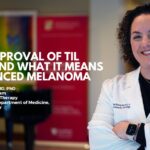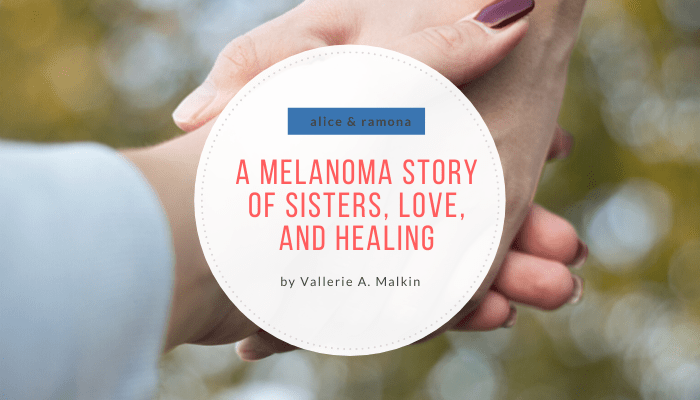
By Vallerie A. Malkin
In her mind and heart, Alice Klunck’s sister will always be a teenager.
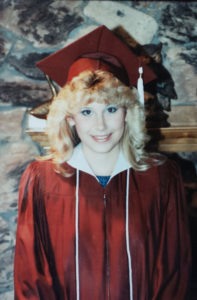
Mona Harris, 1969-1988
Alice was just 12 years old when her 18-year-old sister, Ramona (“Mona”) Harris was diagnosed with melanoma. It was 1987, when girls slathered themselves with baby oil and iodine, lying on silver foil blankets that trapped the sun’s rays so they could be darker.
Tanning booths were all the rage, too: You climbed into a long, rectangular, coffin-like “bed,” closing the lid over yourself for 30 minutes and emerged brown as a berry. Girls who were light or freckled emerged with scarlet sunburns.
The word was that in half the time, you’d be twice as tan and much safer using a tanning bed. Those words turned out to be true in terms of getting darker, but tanning beds are not safe at all, and research indicates that indoor tanning may cause upwards of 400,000 cases of skin cancer and 6,000 cases of melanoma each year.
Mona had probably been in a tanning bed only three or four times in her entire life, recalls Alice, who is now 44. Like most teenage girls, Mona labored to make her fair skin darker for events or sometimes just for fun.
Alice hadn’t been interested in all that. She liked to play sports: volleyball, softball, and basketball. She was Mona’s “bratty younger sister,” but Alice idolized her: “Mona was everything to me,” says Alice.
A slew of family pictures will show you the Harris sisters going about their young lives: two smiling little girls, Alice with darker hair, Mona with lighter hair, pictured side by side in front of a flower bush with Mona’s hand protectively placed on her sister’s arm; Mona in a peach frock with matching shoes and a wrist corsage at her senior prom; Mona in her rust-colored cap and gown at graduation; Mona with her sister and parents, relaxing at home.
Mona had a family who loved her, a boyfriend she adored, and lots of friends. Mona was enrolled in community college, scheduled to start in September.
Mona would not be able to finish out the semester at college because soon after graduation, melanoma darkened her doorstep and tipped her family’s life upside down.
Teenager, Interrupted
In April of 1987, Mona discovered a mole on her lower calf when she nicked it while shaving her legs.
“It didn’t look good,” recalls Alice. When the mole grew back rather quickly, Mona’s mother was alarmed and took her to a dermatologist. After Mona’s prom, she saw a general surgeon at a local hospital in Dallas, near the family’s home.
The surgeon removed a banana-sized slice of tissue from Mona’s calf. Alice says her sister was small and thin to begin with, and a lot of muscle mass was extracted, shrinking the leg considerably right before Mona’s high school graduation in June. Mona and her parents were told she had melanoma.
Mona was referred to the University of Texas MD Anderson Cancer Center in Houston in the fall for another surgery to have the margins removed and her lymph nodes biopsied. Mona and her parents, Larry and Becky Harris, were told that her prognosis was grim.
Alice didn’t know that melanoma is one of the most lethal cancers to have. “It was the 80s,” recalls Alice, “I thought it was ‘just skin cancer,’ and you don’t die from that.”
Doctors told Mona and her parents that the melanoma had spread to her brain and that she did not have long to live.
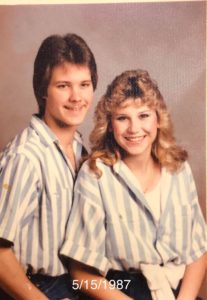
Upon learning the bad news, Greg proposed to Mona in November.
Alice’s parents shielded Alice from the news, but Mona’s boyfriend Greg Hooker, was in the know. “Mona lived for the boyfriend,” says Alice. Upon learning the bad news, Greg proposed to Mona in November.
Alice doesn’t fault her parents in the least for shielding her; she knows they were doing what they thought was best at the time. But these days Alice does tend to be doubtful that she is being told the whole truth when people tell her things in general.
Adds Alice: “I look at it now and think it’s a good thing they sheltered me.” Alice was able to get through her school and activities that year without falling behind. The way things were presented to her, her sister was recuperating, not terminally ill.
“My parents kept me from going through the experience,” says Alice. “If other adults understood the gravity, they didn’t present it to me. You could say I wasn’t able to go through the trauma, and I can tell that has impacted my life.”
In an attempt to eradicate the melanoma, Mona underwent treatment of chemotherapy and radiation at MD Anderson. It was about a 4.5-hour drive from Red Oak, where the Harris family lived, to Houston. Mona lost all of her hair.
Mona’s mother took leave to be with her daughter full-time in the hospital. Mona’s dad continued to work, visiting his daughter in the hospital whenever he could. During the school year, he shuttled Alice to the airport some weekends to see her mother and sister and sometimes Greg or a family friend would pick her up from the airport and bring her home so she could be back to school Monday.
According to Alice, the American Cancer Society helped the family with financial support for travel and hotels, which the family was grateful for.
When they determined that chemo and radiation weren’t working, doctors referred her for a clinical trial at the University of California, Los Angeles (UCLA) Jonsson Comprehensive Cancer Center.
Recalls Alice: “I thought, ‘Good, Mona’s going to California to get well.’” Clinical trials can be effective in some cases and for some people. More importantly, future patients benefit from what is learned in each clinical trial.
Treatments were not successful for Mona, so they were stopped, and doctors scheduled a third surgery in the fall of 1988 when they would operate on the cancer that had spread to Mona’s brain.
Alice began to understand that something serious was happening to her sister when she overheard a conversation her parents were having with the brain surgeon in the hospital in advance of the surgery.
The third surgery took an entire day, and it was brutal: “She was cut and stapled from ear to ear. The entire family was there at the hospital. It was a really fun time in everyone’s life,” says Alice, sarcastically.
Doctors told Mona’s mother and father they could not do anything more for Mona, so about a month after surgery they told her parents to bring her home. While there was no brain damage, Mona suffered extreme light- and sound-sensitivity, though it eventually it subsided.
Mona passed away at home a few months later, on Christmas Day, at the age of 19.
Life After Mona
Mona’s death was a blow that the teenaged Alice was unable to process, and one she has not gotten over. But like most people who have faced devastating losses, Alice found ways to cope, not the least of which is charitable work: a powerful antidote to unimaginable grief, as it turns out.
“My hope is that some of the clinical trials they did at UCLA are helping somebody with melanoma now so that her death wasn’t in vain,” says Alice.
After her death, Mona was the honoree of donations to the Cancer Research Society, which contributed funds to a new laboratory building at the Science Park-Research Division of M.D. Anderson Cancer Center. The new building expanded on the molecular biology program at the Research Division, where scientists are investigating causes and prevention of cancer.
Mona’s death left a terrible void in Alice’s life—and some confusion. Still haunted by thoughts of her sister’s life interrupted, in 2010, Alice Googled “melanoma” and the results of the search turned up AIM at Melanoma’s website. Discovering AIM would be the beginning of a beautiful friendship and it would change the course of Alice’s own life.
Alice decided to participate in one of AIM’s walks to raise money for and awareness of melanoma. AIM Walks, now called Steps Against Melanoma, happen in cities all over the country, from Dallas to Portland to Pittsburgh.
Walks are AIM’s signature fundraising event and raise a significant amount of money each year for its melanoma research initiatives such as the International Melanoma Tissue Bank Consortium—a collaborative, fresh-frozen primary tissue repository, the only one of its kind in the world. Launched in April of 2019 after a decade of dedicated work, the IMTBC brings together six esteemed institutions—four in the U.S. and two in Australia—to collect the tissue and perform much-needed melanoma research on that tissue.
Alice told no one in her family that she was attending the walk. Perhaps this links back to how she was kept in the dark about her sister’s prognosis when she was young, or perhaps she had unfinished business with her older sister, but she wanted her first experience to be private.
At that time, the Dallas walk was still being organized by AIM co-founder Jean Schlipmann, who had lost her husband of 16 years to melanoma while he was in his early 40s. Jean served as director of AIM Walks and Events until early 2019.
“My first walk was emotional. I didn’t tell anyone I was doing it because this was something I wanted to deal with by myself,” explains Alice.
Alice says she took great comfort in being surrounded by people who understood what she had been through. The feeling of being understood brought her back to the event the following year. Her husband had a work conflict and couldn’t attend, so again she attended alone: “That was fine; I still wanted it to be about me and Mona.”
Letting People In
In 2015, Alice talked to Jean about the feeling that she was apart from the walks group-at-large because she attended without any family, and was not walking with a live survivor. With Jean’s encouragement, she told her mother what she had been up to, and her mother said, “Okay, I’m going with you.” Alice recalls feeling a bit uneasy: “It was hard to let other people in,” she explains.
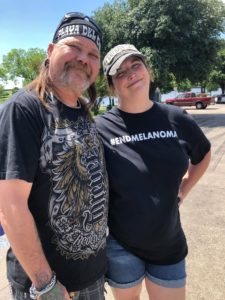
Alice with Mona’s fiancé Greg Hooker
But she did. Alice invited her mother-in-law, her best friend and the friend’s son, and Alice’s daughter, 9-year-old Avery.
Alice had another reason for her reluctance to involve the family: “I knew how I felt the first year and I was worried my mother would be a wreck. She still cries about Mona, like many of us.”
But what happened when Alice introduced other people to the walks was nothing short of miraculous. That year, Alice had reconnected through Facebook with her sister’s fiancé, Greg, who since then had been married, had children, was divorced, and became a grandfather.
Greg had been like a brother to her – he and Mona had been together for three years – so losing Mona meant losing him, too: “It was a double loss,” says Alice. “So reconnecting with him was extremely therapeutic and emotional.”
After Mona’s death, her parents returned all of the jewelry Greg had given her, and he had the rings melted down into a horseshoe nugget ring that he wears to this day, along with the diamond earring Mona had given him.
Alice was delighted that Greg wanted to attend the walk, and nervous because she worried that seeing him would be too much for her mother. She decided not to tell her mother and just let things fall as they may.
When Greg showed up, he and Becky embraced. They had not seen each other in 27 years – since Mona’s funeral.
Becky does not do a lot of physical activity so the walk wasn’t easy for her, but she and Greg managed to make it to the end of the walk around Bachman Lake in Dallas together, after everyone else, and just as Jean had prepared to put the balloons away (some people had even left the event by now).
As they reached the finish line, they both cried, Alice remembers, and Jean captured the moment on film with her camera.
It was then that Alice recognized what had eluded her: “Things were starting to materialize and I thought, ‘Okay, Mona’s not just a ghost, but someone we’re actively talking about and it feels like she’s present.’”
Suddenly Alice realized that this was the missing piece: She needed Mona’s light to keep flickering, and including the people who knew her in the walk did just that.
Protecting Teenage Girls Like Mona
“If you lived in the 80s and you were a girl, tanning is kind of what you did,” says Alice. But now Alice is on a mission to convince teenage girls that this is a dumb and dangerous idea.
Personally, Alice didn’t care much about tanning herself and was teased for being so pale. Now she’s proud that she has taken care of her skin: “At least I don’t have wrinkles!” she laughs.
When girls talk to her about tanning-bed tanning, Alice offers a quick and pointed retort: “Do you not feel it’s a coffin?”
“I’ve spent most of my time trying to help teenage girls,” says Alice. Now that she has one – in fact, Avery is 13, the same age Alice was when Mona passed from melanoma (and she shares the middle name “Dian” with her aunt) – Alice is even more adamant about sun protection.
Alice goes right to the punch with the girls: “You may be tan now, but when you’re lying in your casket, you’re going to be pale.” Macabre? Sure. Truthful? Absolutely.
Walking the Walks
At the 2015 AIM walk in Dallas, Alice spoke briefly about her sister. Jean had advised her: “Talk about her, not the disease.” Alice says it is hard to separate them, and that’s one of the tragedies of losing someone to an illness. It is also a big part of doing charity work in memory of somebody lost to melanoma. But Alice thinks of future melanoma victims who might become survivors because of the funds she and her teams have raised, and this keeps her going.
In 2017 Alice learned the Dallas walk would not come around that year because Jean was retiring. For Alice, it was like losing her sister all over again to think of not being able to attend the walk. So Alice decided to take up the mantle after Jean left.
The following year, she and Jean put the event on together. Alice tried to personalize the event and incorporated painted rocks into the festivities. One rock said, “You’re a warrior.” Another would have a different saying or a survivor’s name. Alice invited participants to take a rock home to remember the experience.
Usually, planes would take off as everyone started walking, but that year Alice let a speaker talk too long and at the end of the ceremonies, when roll call took place, planes started taking off. They had to pause to wait for the sound of plane engines to subside.
When the walk started and Alice was able to talk to Jean, she asked why she had never noticed the planes taking off at Dallas Love Field before.
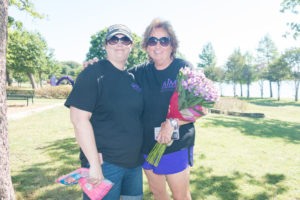 In 14 years, Jean had figured out the timeline of the plane departures and had planned the opening ceremonies around them. That’s why she was most adamant about this one piece of advice: “Stay on time.”
In 14 years, Jean had figured out the timeline of the plane departures and had planned the opening ceremonies around them. That’s why she was most adamant about this one piece of advice: “Stay on time.”
“I feel very fortunate that I got that first year with Jean, who was a huge help, and then I figured out the rest,” says Alice. There were 288 participants (including Alice’s husband) in 2018 and they raised $50,000.
The following year, in 2019, the Dallas walk had 30 volunteers and 407 participants. Usually, Alice’s whole family ends up working the event—everything from collecting registration money to giving away T-shirts to fundraising participants who haven’t already decided to make their own. They raised more than $30,000 for melanoma research that year.
Alice’s goal for the 2020 walk is to raise $40,000: “Preparations are in full swing for this year’s walk, which will take place May 2,” says Alice. Alice has her own photography business and is busy but she continues to make time for the walk and will do so until it feels like the right time to hand the baton to someone else.
Alice has gotten a lot out of her work with AIM on Steps Against Melanoma. Through the walks, she has reconnected with old friends who were like family members. The walks keep her sister’s memory alive and flickering brightly each year: “This is an outlet and it has brought my family together to be able to have conversations about Mona.”
No matter how many people Alice enlists to participate in the walks, each year’s walk continues to be a private moment between Alice and the sister she loved. “When they read the names of the deceased,” she said, “they go in order from youngest to oldest. Each year I pray that no one comes before my sister. When I hear her name first, I think, ‘Thank God.’”
What Might Have Been
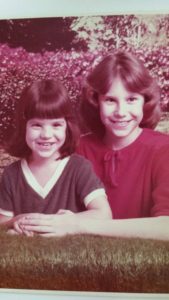
Alice & Mona
This summer Alice will be 45 years old. Mona, if she were still alive, would be 51 years old. Alice wonders what kind of a life Mona would have had and what kind of a relationship they would have had now. When thinking about her sister, Alice’s emotions can move quickly from regret and sadness, to fondness, inspiration, and accomplishment. Mona’s memory shines brightly for Alice, and she is proud of all the research that can be done through the funds raised at the walks. That research will prevent the deaths of beautiful teenagers like Mona in the future—and maybe even lead to a cure.
“I hope I see that in my lifetime,” says Alice.
What does Alice think her older sister would think of her bratty teenaged sister now? “I hope she would be proud,” says Alice.
To help Alice raise money in her sister’s memory, visit https://support.aimatmelanoma.org/Dallas2020
Connect with Alice on Twitter @alice_klunck or at Facebook (search Alice Harris Klunck) to learn more about the upcoming walk.
Find out about other AIM walks around the country.
Recent Posts
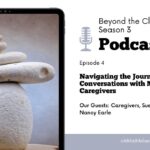
Navigating the Journey Together – Conversations with Melanoma Caregivers
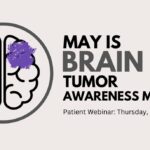
May is Brain Tumor Awareness Month

President’s Letter | April 2024

Celebrating a Milestone: 20 Years of the Dallas Steps Against Melanoma Walk
